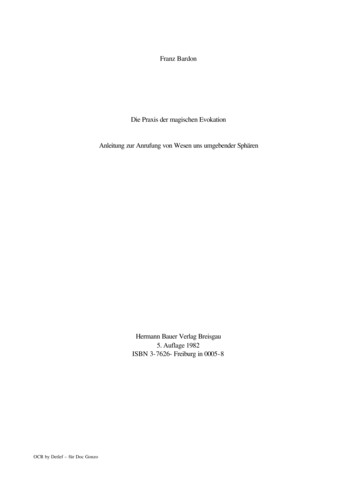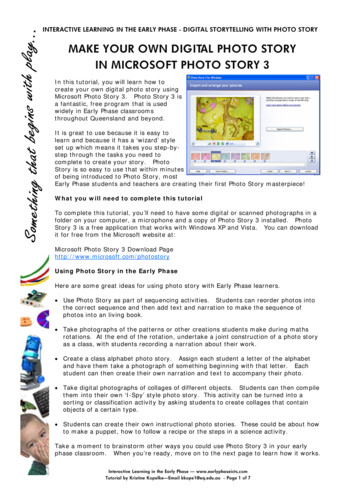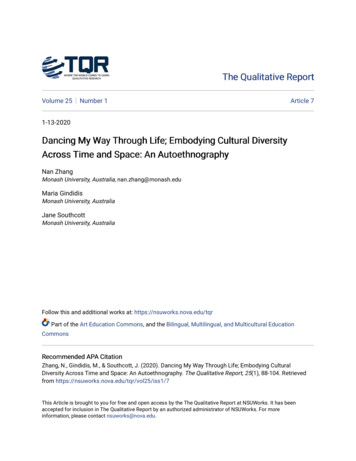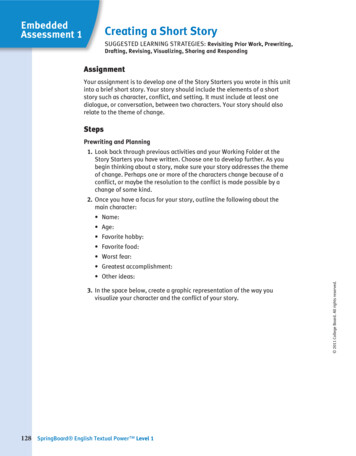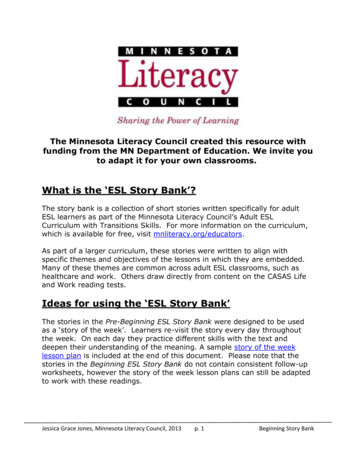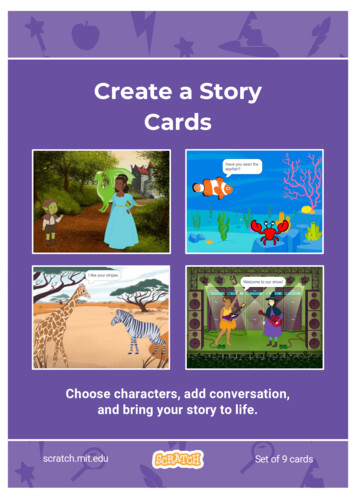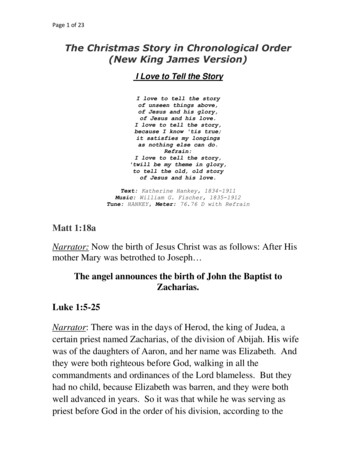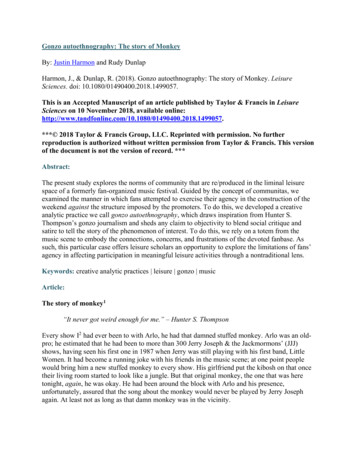
Transcription
Gonzo autoethnography: The story of MonkeyBy: Justin Harmon and Rudy DunlapHarmon, J., & Dunlap, R. (2018). Gonzo autoethnography: The story of Monkey. LeisureSciences. doi: 10.1080/01490400.2018.1499057.This is an Accepted Manuscript of an article published by Taylor & Francis in LeisureSciences on 10 November 2018, available .2018.1499057.*** 2018 Taylor & Francis Group, LLC. Reprinted with permission. No furtherreproduction is authorized without written permission from Taylor & Francis. This versionof the document is not the version of record. ***Abstract:The present study explores the norms of community that are re/produced in the liminal leisurespace of a formerly fan-organized music festival. Guided by the concept of communitas, weexamined the manner in which fans attempted to exercise their agency in the construction of theweekend against the structure imposed by the promoters. To do this, we developed a creativeanalytic practice we call gonzo autoethnography, which draws inspiration from Hunter S.Thompson’s gonzo journalism and sheds any claim to objectivity to blend social critique andsatire to tell the story of the phenomenon of interest. To do this, we rely on a totem from themusic scene to embody the connections, concerns, and frustrations of the devoted fanbase. Assuch, this particular case offers leisure scholars an opportunity to explore the limitations of fans’agency in affecting participation in meaningful leisure activities through a nontraditional lens.Keywords: creative analytic practices leisure gonzo musicArticle:The story of monkey1“It never got weird enough for me.” – Hunter S. ThompsonEvery show I2 had ever been to with Arlo, he had that damned stuffed monkey. Arlo was an oldpro; he estimated that he had been to more than 300 Jerry Joseph & the Jackmormons’ (JJJ)shows, having seen his first one in 1987 when Jerry was still playing with his first band, LittleWomen. It had become a running joke with his friends in the music scene; at one point peoplewould bring him a new stuffed monkey to every show. His girlfriend put the kibosh on that oncetheir living room started to look like a jungle. But that original monkey, the one that was heretonight, again, he was okay. He had been around the block with Arlo and his presence,unfortunately, assured that the song about the monkey would never be played by Jerry Josephagain. At least not as long as that damn monkey was in the vicinity.
Monkey was hanging out with Arlo on the first day of the Dixie Mattress Festival (DMF; 2016),a festival centered on the music of the Jackmormons. I mean that literally: the monkey washanging from his neck, equipped with a mini disco ball around his neck. I asked Arlo why he stillbrings that monkey to shows being that its presence essentially guarantees the song will not beplayed if Jerry catches sight or wind of Monkey. His response was, “The song ain’t gonna beplayed anyways. But if it were, Monkey would be awfully pissed to miss it.” I could not arguewith that. I had ascribed life to many of my most treasured inanimate objects in the past. Ofcourse, I was 7 years old when I did so.Monkey was full of spirit for this year’s rendition of Dixie. Last year’s installment was supposedto be the last. After seven years, the promoters, Kirk and Kelly, a husband and wife team,decided to step away. It was a labor of love that often ended in a lighter bank account. After lastyear’s rendition, everyone was hopeful that someone would take the reins and keep the festivalgoing. It had become a very important mechanism in the functioning of this fan community.As the adage goes, “Be careful what you wish for. It just might come true.” Someone did indeedstep up to put on Dixie again: Jerry’s band and their production company. This was curious on anumber of levels. For one, they had tried to host an annual festival in the past, and it fizzled outafter two attempts. For another, their intentions were to skirt much of what was so special to thefestival in the first place: put on by fans, for fans, centered on the music of the Jackmormons,and free from any sort of “official” oversight. At the past festivals you could do whatever youwanted. It was kind of like international waters. This rendition was attempting to be both aprofitable event and to cater to a wider swath of music fans. The festival, that was named afterone of the band’s songs and centered exclusively on their music, was rumored to be moving to amodel where the Jackmormons were no longer going to be the main attraction. This couldpotentially be good for the bottom line, but it would be counterproductive to the functioning ofthe fan community.This past year the promoters introduced other notable bands into the lineup, they shortened thesets of the Jackmormons, they installed VIP camping, seating, and food, they hired outsidesecurity, and they expected the fans to alter their daytime plans to meet the expectations of theproduction team. In the past, the days were for fellowship, getting reacquainted, side trips andadventures, all with the purpose of building the cohesiveness of the community. Nighttime wasfor the band and its music. But this year there were other musicians performing throughout theday. The new Dixie crew wanted to push the model to resemble the music festivals that nowscatter North America every summer. They wanted to be something they were not, somethingthey could not be, and most importantly, something the fans did not want them to be.So when it came time to get ready for the first night of three Jackmormons’ shows, Monkey hadto try something new. Sure, his song was not going to get played, but he was going to remind theband why the fans were there: to recreate the spirit of community that formed around this bandover decades of involvement, travel, sacrifice, and pure love of the music. Jerry and the bandcannot control the community, but they do benefit from its existence. This was something theproduction team appeared not to have considered in its attempts to change the model of Dixie.To this end, this project endeavors to describe the unique power dynamic that exists between JJJand their fan community.
To capture the essence of the indulgence of the DMF, we took the road “less traveled” to tell thestory of that weekend. The majority of fans at Jackmormons’ concerts are in their late 40s andearly 50s, and most have been seeing the band perform for 10 years, 15 years, or longer. So whena beloved fan-run event was usurped by the very band the fans love, and then changed to be afraction of its former self, it was easy to understand why the fanbase would be concerned. Butjust as this was the case, the fans were also reliant on these music-filled weekends to uphold theirfan community; without them, there is no mechanism to maintain the connections they built overyears of shared experiences.Monkey’s coming homeI was standing behind Arlo who was wearing the knapsack that Monkey slept in. A crowd of 200or so fans packed in, many close to the stage, some on the periphery to hide in the shadows oftheir indulgences and the reaches of the soon-to-be chaotic sound. The stage was thinly dressedin décor, with only the bare essentials evident (amps, drums, guitars), indicating that what wasabout to happen was not for the feint-of-heart. The onlookers eagerly awaited the impendingjumpstart to their hearts that would be delivered through channeling the spirits of Robert Johnsonat the crossroads. Jerry walked out, plugged in his guitar, and took one violent strum; the soundwas reminiscent of a jet flying low, but at high speed. And just as that strum echoed through thebones of all those in attendance, a flash of light blinded us in the dark countryside of ruralOregon. As if on cue, Monkey popped his head through the zippered pack:“Fuck yea!!!!” Everyone looked around to see who could possibly scream so loud as to shut outJerry’s demon-coated attacks on his guitar; all anyone saw were looks of astonishment aseveryone tried to recover from the blinding light and cacophonous mixture of rock n’ roll and anindiscernible voice.Jerry bellowed obnoxiously, “Move it, you little shit,” and the sound echoed throughout the dark,damp field. This was not the opening lyric to any of Jerry’s songs, yet no one knew to whom itwas addressed. With all attention now turned toward Jerry, but without any music playing, thefans began to froth at the mouth for rock n’ roll. They had been waiting all day for their next fix,and something — or somebody — was keeping them from it. But who?At about that time, Jerry screamed for security and a number of dimwitted ruffians ran up to thestage ready to answer to his cry. But just as he was about to tell the foot-soldiers who or what toremove from the stage, the crowd’s frustration, impatience, and drug-addled gusto turned fromthe uncertain and onto Jerry. He looked at the crowd and then back again at his henchmen andtold them to stop. He ordered them off the stage and appeared as if he was going to handlewhatever matter it was that was keeping him from rock n’ roll decadence. As Jerry looked backat the crowd, he could tell that they had their sights on him now. He was the one transgressing ontheir good time, not some foolish interloper.“Not so fast, friend. You throw me out and you’re going to have a world of hurt from that gangout there,” said Monkey. Jerry and Monkey stared at one another menacingly, each steppingslowly closer until the only possible outcome would be a flat-out street fight. Monkey spread his
tiny body out as wide as he could, bared his fangs, and put on his thousand-yard-stare. The hairson Jerry’s neck stood up so straight that they glistened with sweat in the dim glow of the stagelights. Jerry then looked past Monkey to the crowd, who by then were teetering on the edge ofpandemonium, quivering for rock n’ roll but ready to roll up their sleeves. Jerry mumbled, “Atleast get out of my way.” Monkey smiled triumphantly and extended one arm with a “thumbsup” sign to the crowd who cheered wildly. The other arm faced Jerry with his middle fingerextended. Monkey wasn’t going to back down, and he decided he should be a reminder for theduration of the weekend to his friends that they needed to stand up for what they had helpedcreate. Monkey walked over to the two stage monitors Jerry used and took his place for theweekend. Then he said to Jerry, “Okay, you can start now.”What Monkey represents in the fanbase of this music scene is continuity, dedication, travel, livedexperience, the building of friendships, and a point of reference. Much as other tokens, catchphrases, and idioms of past participation have found their way into the scene, Monkey wears thecrown as the most dedicated, and longest lasting, of all Jerry’s fans. So in the spirit of buildingtraditions through music and fellowship, why would the band and their promoters try to buck thesystem?Earlier that weekend when Monkey arrived at the venue, he jumped out of Arlo’s truck after along drive from Flagstaff, Arizona. Dixie was yet again in a new location, and while one mightassume this could affect the continuity of the weekend, it never did. The “spirit of Dixie” was inthe music and the fans; nothing else really mattered.Monkey quickly galloped to the check-in table, though no one was there. He wrapped his furryknuckles loudly on the plastic surface, impatiently trying to get the attention of someone. Slowly,and in a somewhat agitated fashion, a member of the band’s promotion team piqued his headaround the corner and said, “Yea? What do you want?” Monkey turned up his lip and glared afang, clearly frustrated by the poor customer service. He barked, “Give me my bracelet. I’mready to add to my collection.” The roadie fumbled around through a box and produced a strip ofpaper bracelets, nothing like the ornately produced rubber bracelets of all the year’s past.Monkey shouted, “Wait, wait, wait! Where’s the nice ones? Are those for rookies orsomething?” The roadie stared blankly at the stuffed animal, unsure if he was awake; it had onlynow settled in on him that he was talking to a toy. Monkey continued, “Nevermind. Where’ssomebody who knows what the hell is going on here?”Even though this year was being hosted by another team, most people expected to add anotherrubber bracelet to their collection. For all the previous Dixie’s, every fan in attendance was givena colorful rubber bracelet embossed with the name and year of the festival. It was common forthe fans to wear the bracelets from every year they attended to the following year’s rendition.While seemingly a trivial component, it represented another break in the link of tradition. Itsignaled that the new promoter’s attention was on other things, such as having a VIP space andseparating the fanbase into a class system. Monkey was displeased.
The campground at Dixie has always been known as “Trenchtown,” named after Bob Marley’sneighborhood in Jamaica. Many of us were hanging out in Trenchtown around 2 am after thefirst night’s concert, buzzed from booze and chatting up a storm. I stepped back and took a sip ofmy beer, trying to hone in on where I should intervene. As luck would have it, Monkey ambledup to me and said, “Were you at the first Dixie?” Before I could say “No,” Monkey lectured tome, “Well, you should’ve been. It was great. It really was a vision to behold. Have you ever readKirk’s ‘The Vision’ statement from that first year?” I had read it, but I did not recall its specificcontents. Kirk had written up a statement before each year’s festival telling the fans what it wasabout, who should be there, why it was important, and how special this community was. “TheVision” statement stated how these fan-run events were unique, and we should not take them forgranted. In short, if you were a true fan of the Jackmormons’ music and you consider yourself a
member of the fan community, then you should not miss out. Monkey went on: “All seven weresimilar, but that first one, that first one really set the mark for us to follow. It gave us somethingto think about it. I read it every day for like two months before going to that first Dixie. By thetime the festival started, I was primed and ready.” I mentioned that I knew the sentiment andtone of each missive, and then was reminded that there was not a “Vision” statement this year.Monkey continued, “That’s right. And do you know why?” Not waiting for me to respond helooked at a crumpled up piece of paper and began to read:This show is being put on by people like you for people like you. There will never be thepursuit of profit, rather the goal of providing shows in a festival type environment for thefolks who want to see Jerry Joseph & the Jackmormons, but not at a festival performingbehind and alongside a lot of other bands Growth is secondary. Maintaining theuniqueness, the special experience is the primary purpose He asked me if he should go on. I said, “No.” I got what he was getting at. Then Monkey spokeup again and said, “What do you see happening here that isn’t in line with what I just read?” Isaid, “Well, for one, the Jackmormons aren’t as much a part of the festival as they oncewere.” Monkey replied, “Bingo.”Most of the fans spent the final day down on the river as temperatures crept up into the high 80s.Bands were lined up from noon on, and while there were nationally recognized musiciansplaying, the field in front of the stage was about half as filled as it should have been for thenumber of tickets sold. But Monkey was there, still holding down the fort on the stage betweenthe monitors. With his arms outstretched he yelled to the masses, “Go, be free, my friends. Makethis weekend what it should be: a celebration of our community. The Jackmormons don’t start‘til 9 pm.”When it came time for the Jackmormons to play their final set of the weekend, the band broughtup on stage one of the musicians from a group who had played that afternoon. Jerry said, “We’regoing to bring out Eric from Dragondeer who played earlier today. They kicked ass, but none ofyou would know that because you were all down at the river.” Everyone was used to Jerrythrowing a tantrum. He often chided people from the stage, especially if they were talking upfront, belligerently drunk, or yelling obsessively to play a certain song. But this time I caught afew people shake their heads and roll their eyes. It was easy to infer at that moment that theywere just fine with their decision to enjoy the company of their friends. Yes, they came for themusic — Jerry’s music, and his music only — but what made the weekend extra special was thefriends they shared it with.When the final note ended, earlier than advertised I must add, fans walked back to Trenchtown insilence. Monkey jumped off the perch he had maintained for the weekend and onto my back,holding on to my ears like the reins of a horse. He tugged on my lobes and I stopped, both of usturning back to the stage one last time. Monkey blew a kiss to Jerry, and Jerry caught it and thenblew one back. They shared a chuckle and then Monkey prodded me forward. We walked theremainder of the distance in silence until we approached the after-hours celebration atTrenchtown; then Monkey catapulted off my back and somewhere into the night. I heard a loud
cheer and a beer being cracked open and knew that everyone was being regaled by stories fromMonkey’s heroic weekend.Worn out from a great weekend of camaraderie and revelry, many had to start thinking aboutreturning to the “real world” sooner than preferred. As if on cue, Monkey said, “Jerry’s adick.” We all laughed and the conversation soon turned to all the hours of Jackmormons’ musicwe had expected to hear but were shortened. Typically over Dixie weekend in the past the bandplayed roughly 14 hours over four shows in three days. This weekend we got three shows inthree days and maybe eight hours of music.I said, “Well, another one down. What did y’all think? Think it’ll happen again next year?” Noone spoke at first, and those that were having their own discussions abruptly wound them downas if a dinner bell had been rung and captured their attention. Monkey interjected, “You knowguys, they can do whatever the fuck they want. It’s their right. But they better not call it Dixieand try to pass it off as such. This is our festival. It was done for all of us. Not for their agenda. Ifyou want to do it your way, call it something else.”I had a 7 am flight the next day, so I wasn’t planning on getting much sleep and decided to see ifpeople needed any help tearing down so they could hit the road early the next day. Arlo’s campwas in need of breakdown, so I helped him pack up his kitchen stuff. Monkey was sitting on thebumper of Arlo’s truck, and the little beast began to sing to me: “We will sing his praises, kneelbefore his throne. Clap your hands together, monkey coming home.” I looked at him andsaid, “Huh?” Monkey responded, “Those are lyrics from my song. It’s time to go home.” I thenasked Monkey, “So was it a good weekend?” He replied, “Of course it was a good weekend. Ilove you people. I love this band. Did they miss the mark a bit? Yea, they did. But even thoughthey made some missteps, the weekend still happened. If it hadn’t, it would have been one lessweekend that I could have spent with all of you.”
Epilogue (scholarly treatment)Creative influenceIn this article, we developed a creative analytic practice (CAP) (Parry & Johnson, 2007;Richardson, 2000) we call gonzo autoethnography to explore the ephemeral moments of fansattending a festival for the rock band Jerry Joseph & the Jackmormons. It is in this conceptualeffort that we drew on Hunter S. Thompson’s (1971, 1979) method of storytelling to narrate howcommunities expressed the sentiment of their shared leisure experience. Parry and Johnson(2007) asserted that the personal and social meanings of our participants are the most importantdepiction of the lived experience, trumping any attempt at generalization. But sometimes thosesentiments get lost in the fray or do not resonate the way we hope they would, thus suggestingthat an injection of authorial creativity may be warranted at times.According to Thompson (1979), gonzo journalism is “a style of ‘reporting’ based on WilliamFaulkner’s idea that the best fiction is far more true than any kind of journalism — and the bestjournalists have always known this” (p. 106). Thompson went on to say that this:Is not to say that Fiction is necessarily “more true” than Journalism or vice versa – butthat both “fiction” and “journalism” are artificial categories; and that both forms, at theirbest, are only two different means to the same end True gonzo reporting needs thetalents of a master journalist, the eye of an artist/photographer and the heavy balls of anactor. The writer must be a participant in the scene, while he’s writing it Only agoddamn lunatic would write a thing like this and then claim it was true. (pp. 107–108)Speaking of Thompson’s writing style in his seminal “gonzo” piece, “The Kentucky Derby isDecadent and Depraved,” The Boston Globe editor Bill Cardoso said in 1970 that Thompson’suse of the first person, his manic reporting of events, and the blending of fact and fiction todocument a “true” story was cutting-edge and innovative; it was “gonzo journalism”(Hirst, 2004). Thompson embraced the moniker and applied it to his unique style of journalismfor the remainder of his writing days. It is in this conceptual effort that we borrowed fromThompsons’s long and illustrious career to apply his method in a slightly more rigorous andacademic way to tell the story of what happened in a leisure experience when we shed ourunderstanding of what it means to “do research.” To borrow from Thompson’s (1971) classicwork, Fear and Loathing in Las Vegas, “But what was the story? Nobody had bothered to say.So we would have to drum it up on our own ” (p. 12).Theoretical perspective“We don’t cover the story, we become the story.” – Ralph Steadman, Thompson’sillustratorSince the bulk of data collection took place in the interstitial moments of the music festival, itwould be appropriate to ground any philosophical understanding of this liminality in VictorTurner’s (1969) groundbreaking work on the concept of communitas. Turner outlined three
primary forms of communitas: normative, ideological, and spontaneous, the latter of mostimportance to our focus on subcultural affiliation’s ability to affect fan sentiment and practices asrepresented through Monkey.Spontaneous communitas is “richly charged with affects, mainly pleasurable ones” (p. 139),which occur in the ephemeral moments of shared participation in a meaningful leisure activity.When freed from the mundanity of their everyday lives, the liminal and fleeting moments ofcommunitas that take place in leisure possess the potential to grow community due to theexcitement of participation in celebratory events, like music fan communities. Turner’s liminalstages of communitas are effective in creating significant shared moments of interaction betweenfans where meanings are constructed and subcultural languages, norms, and totems areestablished to reinforce the bonds, and importance, of affiliation and participation through music.It is in the liminality of communitas where we see a “transformative experience that goes to theheart of each person’s being and finds in it something communal and shared” (Olaveson, 2001,p. 105); in this instance the music of Jerry Joseph and fan community built around it.In this article, we focused on the small but tightknit music community to showcase Turner’sliminality in the “betwixt and between” moments of fan participation that helped establish ourconceptual gonzo autoethnographic endeavor. Music scenes are composed of ephemeral, yetregenerative, spaces that serve as an inviting forum for people with likeminded tastes to buildsocial relationships that affect their sense of self (Driver, 2011). While the episodic interactionsthat occur in a music scene are fleeting by their very nature, music scenes and fan affiliationsendure for long durations and, in many cases for decades, and possess the ability to be positivemarkers of self and growth through stability and continuity for aging fans (Taylor, 2010). Thefans who comprise music scenes are both subjects and objects of their interactions withthemselves, their fellow fans, and the music as well as the totems that are established throughpersonal and communal investment in their beloved leisure (Harmon & Kyle, 2016). In thisinstance, the collective fan sentiment is captured and reconstructed in a way that sheds any claimto objectivity to blend social critique, humor, factual liberties, and satire to tell the story of thefan community through its beloved “mascot,” Monkey.This distinct epistemology of gonzo autoethnography required foregoing the structural aspects ofpopular contemporary forms of understanding and representation of data to tell a story outsidethe lines of traditional, positivistic representations of research (Lincoln & Guba, 2005),embracing aspects of how reality is socially constructed (Berger & Luckmann, 1967). Caron(1985) said of Thompson’s writing style that “facts were fuel for his imagination” and that gonzojournalism insisted on the writer’s involvement with the phenomenon to insert moments ofabsurdity to tell a more entertaining story. “The Story of Monkey” is based in equal partsabsurdity and imagination, as well as the shared histories and complicated meanings derivativeof being a member of the fan community.In a conceptual piece that sought to outline what gonzo ethnography might look like, Sefcovic(1995) said that gonzo journalism was sensationalistic, “vividly descriptive and rabidlyopinionated,” and relied on “extreme” forms of ethnographic observation and storytelling (p. 20).For Sefcovic, gonzo ethnography in practice would then:
Reject the notion of any privileged vantage point for observation, insist on recognition ofthe participatory dimension of the researcher’s role, and urge experiments with researchmethods and reporting practices that can liberate and empower general audiences. (p. 21)Building off of Sevcovic’s work, Wozniak (2014) detailed his use of the gonzo ideology in hiswork with Kurdish police forces to create what he called “gonzo sociology.” Wozniak said thatthe point of gonzo sociology was to go where others had not and “reopen the space for wild,immersive, and messy research which captures the imagination” and still delivers the message,albeit in a nontraditional manner (p. 471).Humphreys (2005) said that finding the “ultimate truth” in a story does not require accuracy somuch as the meaning that is taken away by the reader. In our reliance on a stylized CAPrepresentation of storytelling, we attempt to reflect the social meanings rather than try to reducethose meanings to generalizations (Parry & Johnson, 2007). Berbary (2011) stated that:CAP changes our expectations of research because rather than disconnect and reduceexperiences, it instead encourages involvement, inspires curiosity, creates inclusivity, andconstructs depictions that remain in the thoughts of readers in ways that traditionalrepresentations sometimes do not. (p. 195)CAP is supposed to be “unruly” and creative; pushing society out of its complacency andcomfort zones to look at life through multiple lenses and question what we think we “know”(Ellis & Bochner, 2006). As there is no absolute reality in leisure (or life), it should be our goalas mouthpieces of the public to investigate all the places where subjectivity and lived realitiesmay hide (Hemingway, 1995). Researchers who accept multiple realities and embrace newmethods of discovery and representation help to “diffuse” their authority and share it with thepublic, inviting them into the larger discussion on lived experiences and meaning making (Parry& Johnson, 2007). The positivistic school encourages the status quo of the separation of thecreation of a public knowledge from the public. CAP and autoethnography help to “undercutconventions of writing that foster hierarchy and division” (Ellis & Bochner, 2006) by rhetoricallydethroning the researcher. Gonzo auto/ethnography takes it one step further by putting thespotlight on the absurdity of hierarchy and the status quo in research (Hughes, Bridges-Rhoades,& Van Cleave, 2017; Lather, 2013; MacLure, 2013; Mazzei, 2013; Nordstrom, 2017).Drawing off Turner’s (1969) work on liminality and with an eye to the future of researchembracing postqualitative and posthumanistic strategies (Lather, 2013; Lather & St.Pierre, 2013), perhaps we have entered our own period of scholarly liminality where themeanings of lived experiences and the representations of those experiences as scholars are both“betwixt and between” what was and what will be. MacLure (2013) said that contemporaryrepresentations in qualitative research are suffocating and limiting, stating simply and assertivelythat “this needs to change” (p. 658). Consider this approach a heed to that call and a challenge tothe brave to embrace gonzo. Thompson said that the only people who can explain “the edge” arethe ones who have gone over it. Maybe it is time to push what we think we believe aboutscholarship over the cliff and see what comes of it.Methodological approach and reconstruction of data
We devised a novel method of data collection we call “conversation netting” where, withpermission from the participants, the recorder was turned on for hours at a time in socialenvironments where the phenomenon of interest was likely to be discussed. This yielded asignificant amount of unusable data due to the prevalence of conversations that were irrelevant orappeared trivial. But it also kept open the door for the possibility that some thread might arisethat was extremely valuabl
Monkey was hanging out with Arlo on the first day of the Dixie Mattress Festival (DMF; 2016), . everyone was hopeful that someone would take the reins and keep the festival going. It had become a very important mechanism in the functioning of this fan community. . You throw me out


